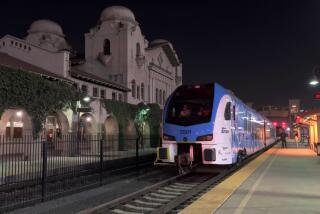Torrance Hitting the Road to Cleaner Air : Transportation: Officials hope that the introduction of an electric bus to the city’s fleet will help spur public awareness and support for low-pollution vehicles.
Torrance plans to unveil a clean-air addition to its public transit system on Monday: a 25-seat electric bus.
The event comes as Torrance officials explore various ways to cut pollution from municipal vehicles. But it also marks a drive by Hughes, a major South Bay defense contractor, to enter the civilian marketplace in an era of shrinking Pentagon budgets.
Hughes Power Control Systems, a Torrance-based division, builds the bus in partnership with Specialty Vehicle Manufacturing Co. of Downey. Hughes hopes Torrance’s use of the bus will build public support, not only for electric buses but also for electric cars, which Hughes is developing with General Motors, its parent company.
“It’s getting a lot of folks familiar with the technology through one vehicle,” said Fred Silver, marketing manager at Hughes Power Control Systems. “What we hope is that (riders) will be saying, ‘Why aren’t we doing this with electric cars as well?’ ”
The city bought the bus with $265,000 in county Proposition C transportation money and $35,000 in county Proposition A funds. Hughes and Specialty Vehicle contributed labor time to build the vehicle. Hughes also will provide free daytime charging of the battery.
Torrance officials have mapped a high-profile route for the bus along Hawthorne, Lomita and Crenshaw boulevards and Skypark Drive. In that area, an estimated 18,000 employees will be able to ride the bus to restaurants, offices, banks and stores.
The bus will traverse the route as many as 30 times a day, including the morning and afternoon rush hours and lunchtime. And for the first month of service, to begin in about two weeks, the rides will be free.
“The whole goal is to demonstrate that electric vehicles do work, that it is viable and the technology is here,” said Ken Allison, director of marketing for Specialty Vehicle Manufacturing.
At first, transit officials are expecting riders to hop aboard simply out of curiosity. The bus will be the largest battery-operated, mass-transit vehicle in the country to operate on major thoroughfares, according to Allison.
“This is going to be something new, and passengers will say, ‘It’s an electric bus. I want a ride,’ ” said Ray Schmidt, Torrance’s transit manager.
While electric buses have been in transit fleets for years, they don’t have the same efficiency, Allison said. The bus will have a range of 75 miles on a charge of eight to 10 hours, but its design allows mechanics to switch batteries within five minutes to keep the bus on the road.
The Hughes ingredient in the bus is the power system, derived from electronics that Hughes developed to power radar aboard military jets. It converts DC battery power to an AC voltage more efficiently than other electric vehicle power systems on the market, according to company officials.
In some respects, the 29-foot bus doesn’t measure up to others in the Torrance fleet. Most of Torrance’s 65 buses are 40 feet long and hold 43 passengers--72% more than the electric bus. Nor can the electric model reach the top speeds of a diesel bus, although it will travel at the city fleet’s average of 18 m.p.h., Schmidt said.
To the makers of the bus, these are just kinks that will be ironed out once future advances in technology allow for lighter batteries and other components.
Riders, Allison said, will begin to prefer the electric buses because of their low emissions. And some motorists who in the past might never have thought of taking mass transit will have second thoughts.
“One of the things that turns people off about mass transit are the noxious fumes,” he said. “If you can eliminate those experiences, these buses become a real treat.”
The vehicle has a low-floor design that makes it easier for passengers in wheelchairs to board.
Until now, Specialty Vehicle has built mainly 22-foot electric buses, which are often used to shuttle passengers short distances. The sale of the Torrance bus marks the company’s move to market larger buses.
Specialty Vehicle is negotiating with the City of Los Angeles to add electric buses similar to the Torrance vehicle to the city transit fleet serving Los Angeles International Airport.
Torrance officials, in the meantime, already are applying for state grants for two more electric buses. And the Chattanooga, Tenn., is scheduled to take delivery in two weeks of six 31-foot electric buses from Specialty Vehicle.
More to Read
Sign up for Essential California
The most important California stories and recommendations in your inbox every morning.
You may occasionally receive promotional content from the Los Angeles Times.










